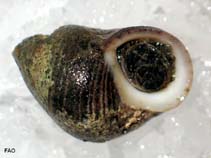Littorina littorea (Linnaeus, 1758)
Common periwinkle| Native range | All suitable habitat | Point map | Year 2050 |

|
| This map was computer-generated and has not yet been reviewed. |
| Littorina littorea AquaMaps Data sources: GBIF OBIS |
Classification / Names Populärnamn | synonymer | CoL | ITIS | WoRMS
Gastropoda | Littorinimorpha | Littorinidae
Environment: milieu / climate zone / djupintervall / distribution range Ekologi
; brackvatten; djupintervall 0 - 60 m (Ref. 83435). Temperate, preferred 11°C (Ref. 107945); 81°N - 22°N, 55°W - 58°E (Ref. 83435)
Distribution Länder | FAO områden | Ekosystem | Förekomster | Utplanteringar
Northeast Atlantic: from west Greenland to Kandalaksha Bay, White Sea, down to Portugal. Said to occur in the Mediterranean during the Pleistocene with records up to the Persian Gulf. Distribution in Iceland possibly true due to its occurrence up to west Greenland. Temperate to polar.
Length at first maturity / Size / Weight / Age
Könsmognad: Lm ?, range 1 - 1.4 cm Max length : 4.2 cm DL hane/ej könsbestämd; (Ref. 83435); rapporterad maxålder: 5 år (Ref. 2823)
Life cycle and mating behavior Könsmognad | Reproduktion | Lek | Eggs | Fecundity | Larvae
Main reference
referenser | Koordinator | Medarbetare
Healy, B. 1997 Long-term changes in a brackish lagoon, Lady's Island Lake, South-east Ireland. Biology and Environment: Proceedings of the Royal Irish Academy. 97B(1):33-51. (Ref. 2779)
IUCN Red List Status
(Ref. 130435: Version 2025-1)
CITES status (Ref. 108899)
CMS (Ref. 116361)
Threat to humans
Human uses
Fiskeri: kommersiell
FAO - fiskeri: landings | FishSource | Sea Around Us
Verktyg
Ytterligare information
Max. ages / sizes
Length-weight rel.
Length-length rel.
Length-frequencies
Mass conversion
Abundans
Internet-källor
BHL | BOLD Systems | CISTI | DiscoverLife | FAO(fiskeri: ; publication : search) | Fishipedia | GenBank (genome, nucleotide) | GloBI | Gomexsi | Google Books | Google Scholar | Google | PubMed | Tree of Life | Wikipedia (Go, sök) | Zoological Record



